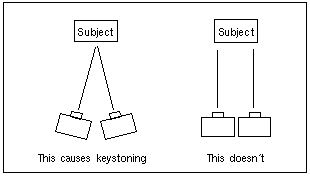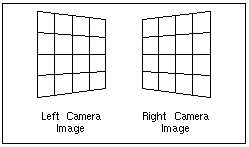
Often someone new to 3D photography feels that, when taking a 3D pair, the camera should "toe-in" towards the subject. This misconception occurs in all 3D photography, but is most pronounced when taking a closeup (macro) shot. It is felt that the camera shots should point in, since that is what the human eye does. The following article describes the keystoning error which occurs if this is done.
What is keystoning (aka "convergence error")?
Consider what an ideal camera is supposed to do. Take an ideal distortion-free camera. Mark a grid of evenly spaced lines on a wall and point the camera at the grid covered wall. Make sure the camera's film plane is parallel to the wall. Take a picture. Look at the picture and it has a grid on it too. It is a "scale drawing" of the grid on the wall. You can lay a ruler on the picture and you will find all the lines are straight. You can use that ruler to measure all the squares in the grid and you'll find they're all the same size.
Now tilt the camera's film plane so it's no longer parallel to the grid-covered wall. Take another picture. This time the lines in the picture are still straight* but the squares are no longer all the same size. Also, the squares have become trapezoids or other sorts of quadrangles. These shapes are called "keystones".


*I'm simplifying slightly here.